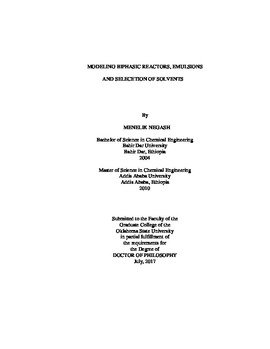| dc.contributor.advisor | Neely, Brian | |
| dc.contributor.author | Negash, Menelik | |
| dc.date.accessioned | 2018-04-23T19:35:55Z | |
| dc.date.available | 2018-04-23T19:35:55Z | |
| dc.date.issued | 2017-07 | |
| dc.identifier.uri | https://hdl.handle.net/11244/299536 | |
| dc.description.abstract | Modeling biphasic reactors (BPRs) facilitates understanding the dynamics between the kinetics and component phase distribution between the two partially miscible phases of the reactor. Using experimental results for bio oil upgrading, an algorithm for the modeling of biphasic reactors describing both reaction kinetics and phase separation was implemented using the simulation of a heterogeneous liquid phase hydrogenation of p-hydroxy benzaldehyde to 4-methylcyclohexanol in a water-decalin mixture. The reaction was represented by the Eley-Rideal type surface reaction mechanism. The Non-Random Two-Liquid (NRTL) phase equilibria model and an interfacial mass transfer model based on the two-film theory was used to assess for representation of the component phase distribution. Aspen Plus and Excel-VBA were used for simulation the reactor. Optimizations was performed to estimate the volumetric interfacial area available for mass transfer. Gibbs energy test was performed to confirm if simultaneous reaction and phase distribution is thermodynamically possible. | |
| dc.description.abstract | Quantitative Structure Property Relation (QSPR) based Linear and non-linear models were used to model emulsion properties such as drop size, emulsion fraction, and emulsion type. The model was validated using experimental data, which includes the effects of the water fraction and the organic compounds used on the emulsion properties. The results of the emulsion modeling were used as a basis for selecting a new solvent with the desired emulsion properties such as selective solubility, drop size and type of emulsion, for use in an emulsion formulation and a BPR. QSPR models for emulsion properties, partition and mass transfer coefficient correlation were used to evaluate performances of different solvents for emulsion development for biphasic reactor. | |
| dc.description.abstract | The simulation results showed that biphasic reactor could offer selectivity of reaction in the desired phase, separation of products with increased organic phase solubility, and continuation of the upgrading process in the presence of component phase distribution. The coefficient of determination values for emulsion property modeling are also comparable or better than values reported for QSPR modeling for other emulsion properties. The importance of emulsion modeling and solvent selection for BPRs was demonstrated successfully | |
| dc.format | application/pdf | |
| dc.language | en_US | |
| dc.rights | Copyright is held by the author who has granted the Oklahoma State University Library the non-exclusive right to share this material in its institutional repository. Contact Digital Library Services at lib-dls@okstate.edu or 405-744-9161 for the permission policy on the use, reproduction or distribution of this material. | |
| dc.title | Modeling biphasic reactors, emulsions and selection of solvents | |
| dc.contributor.committeeMember | Shah, Jindal | |
| dc.contributor.committeeMember | Aichele, Clint | |
| dc.contributor.committeeMember | Hagan, Martin | |
| dc.contributor.committeeMember | Madihally, Sundararajan | |
| osu.filename | Negash_okstate_0664D_15383.pdf | |
| osu.accesstype | Open Access | |
| dc.type.genre | Dissertation | |
| dc.type.material | Text | |
| thesis.degree.discipline | Chemical Engineering | |
| thesis.degree.grantor | Oklahoma State University | |
